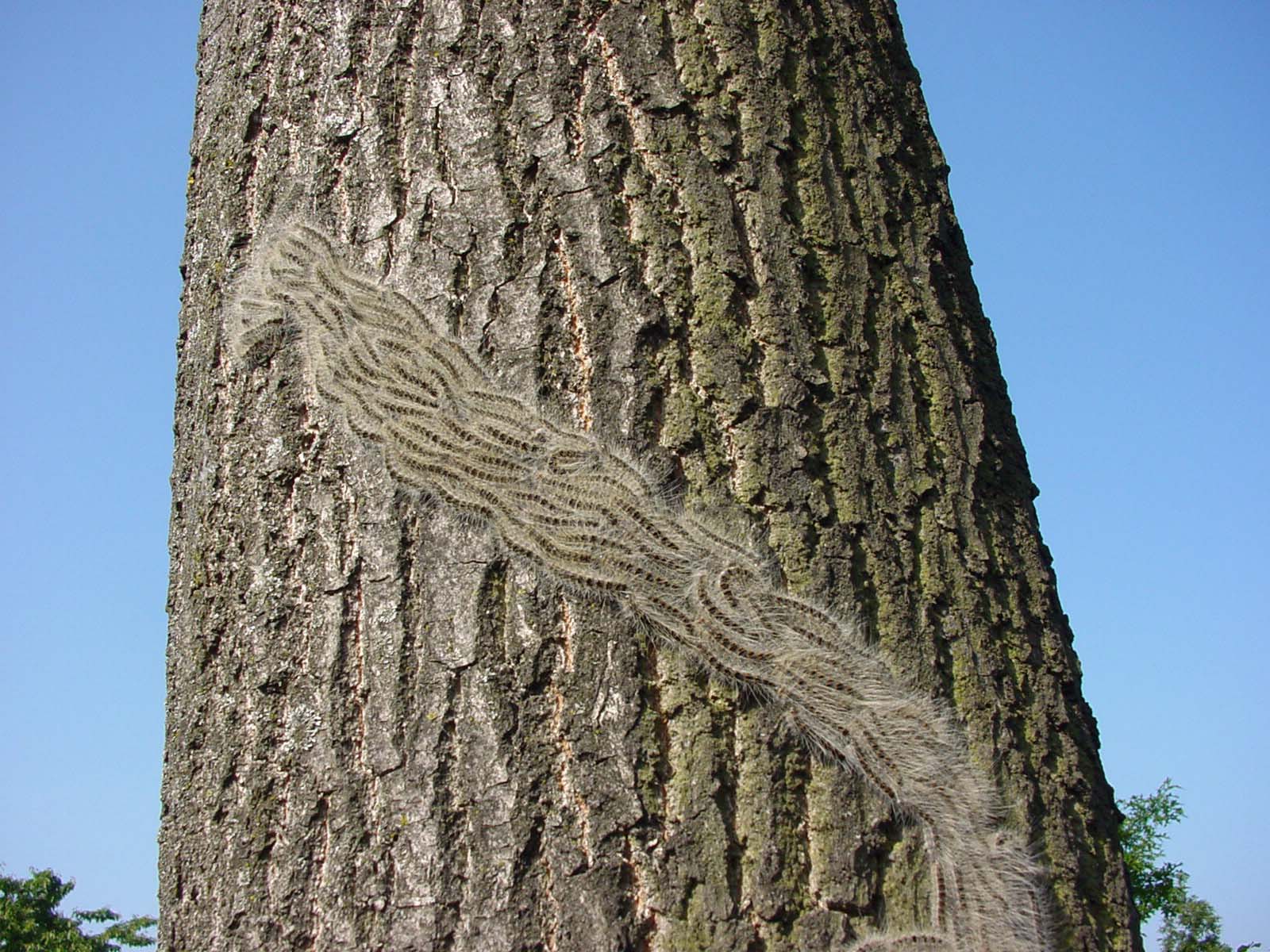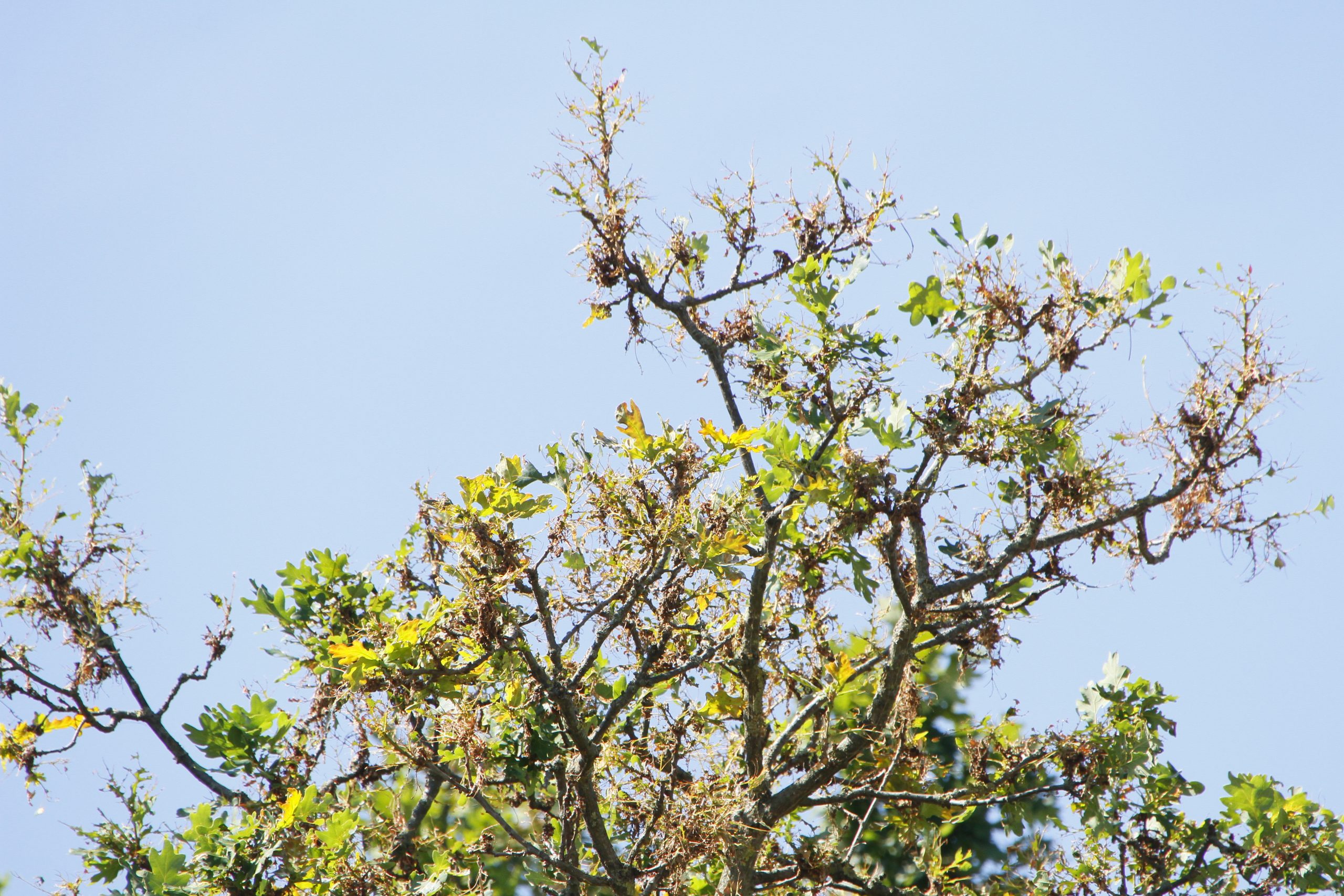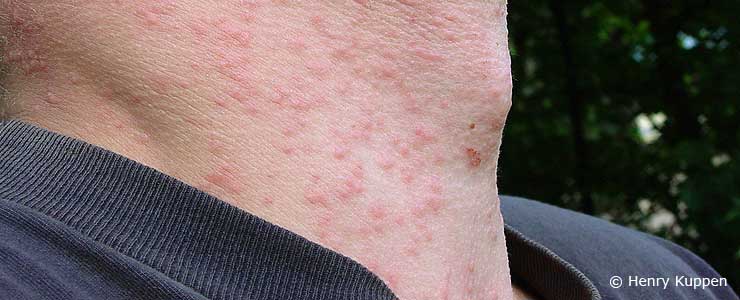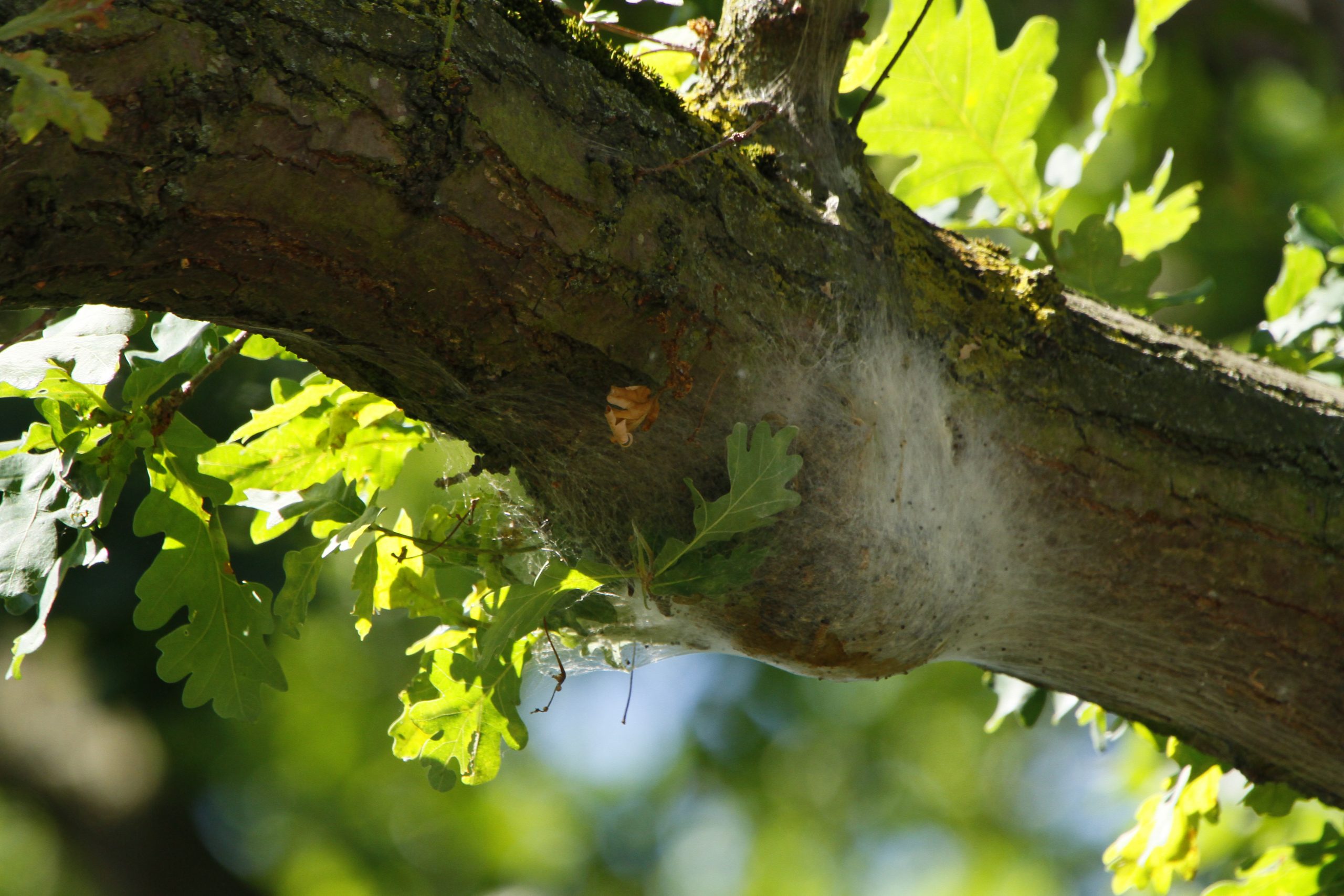Present in UK
Notifiable – see ‘Report a sighting’ below
Scientific name: Thaumetopoea processionea

Picture: Henry Kuppen
The caterpillars (larvae) of oak processionary moth (OPM) are pests of oak trees (trees in the Quercus genus), and a hazard to human and animal health. OPM was first accidentally introduced to England in 2005, and is subject to a government-led programme of survey and control to minimise its population, spread and impacts.
A public information leaflet covering key facts, identification and control of OPM is available. Hard copies can be requested by contacting the OPM team (see ‘Contacts‘ below). The following YouTube video, published by the Forestry Commission, highlights the dangers of OPM (see also ‘The threat to trees‘, ‘The threat to people and animals‘ and ‘Health precautions‘ sections below).
Please note FR is not responsible for, nor we endorse, any of the video content which might be suggested by YouTube before or after this video.
OPM is only known to be established in a relatively small geographical area of the country across London and surrounding areas.
It isn’t possible to eradicate the largest outbreak in London and the surrounding areas, but a government programme has been in place since 2012 to minimise its size, spread and impact. The programme has been adapted over time to account for emerging evidence and surveillance data.
OPM management varies across England to reflect the known distribution of the pest and to protect uninfected areas. The overarching policy objectives for OPM are to slow the spread of OPM, reduce levels of pest prevalence and protect oak resource, whilst also supporting landowners to manage the risks associated with OPM in the areas where OPM is established. One of the goals of government policy is to protect the areas of the country which are free from the pest, which is achieved through measures such as import restrictions on high-risk oak trees, extensive surveillance and targeted treatment of findings of OPM within a buffer area to minimise the risk of spread.
OPM is established in most of Greater London and in some surrounding counties. The remainder of the United Kingdom (UK) is designated as an area free from the pest with special restrictions on movements of oak plants to minimise the risk of introducing OPM to new areas. Strengthened measures on the importation of most species of oak were amended in 2022 to enhance the protection of the UK from further introductions of this pest.
We urge everyone to be vigilant for OPM, in spring and summer particularly, and to report any suspected findings through TreeAlert: see ‘Identification‘ and ‘Report a sighting‘ below for guidance.
Updates from the Forestry Commission’s OPM control programme are available throughout the season through regular OPM programme newsletters.
OPM is established in southern, central and western Europe as far north as Great Britain, northern Germany and The Netherlands.
In the UK, it is established in most of Greater London and in some surrounding counties in South East England as shown in this distribution map.
To help landowners plan OPM management, please refer to the management zones map, as well as a list of local authorities and wards that fall into the buffer zone and established area, by visiting Managing oak processionary moth in England.

OPM is a tree pest because its caterpillars feed on the leaves of several species of oak trees. Large populations can strip whole oak trees bare, leaving them more vulnerable to other pests and diseases, and to other stresses, such as drought. The picture above shows branches of a London oak tree after heavy feeding by OPM caterpillars.

Older caterpillars develop tiny hairs containing an irritating protein called thaumetopoein, from which the species derives part of its scientific name. Contact with the hairs can cause itching skin rashes (pictured above) and eye irritations, as well as sore throats and breathing difficulties in people and animals. The risk of exposure to these hairs is highest in May and June.
The caterpillars can shed the hairs when threatened or disturbed. The hairs can be blown by the wind and they accumulate in the caterpillars’ nests, which can fall to the ground. They can stick to trunks, branches, grass and clothing as well as to equipment, such as ropes, used by tree surgeons and forestry and ground-care workers.
Among the groups most vulnerable to the health hazards are:
Public Health England paper on the health effects of exposure to OPM hairs
We often receive reports of caterpillars which are not OPM, and the following page and poster have guidance on distinguishing between OPM caterpillars and those of other species:
Otherwise, OPM caterpillars have the following distinguishing characteristics:
See also:

Older caterpillars feed mainly at night and remain in their nests during the day. Later in the summer they retreat completely into the nests as pupae, re-emerging a few weeks later as adult moths.
OPM moths (the adult form of the species) are undistinctive brown moths which are difficult to accurately identify because they are similar to a number of species. They are not a health hazard, and the plant health authorities do not require reports of moth sightings. However, we do accept reports of OPM moths, especially females, caught in light traps by moth recorders who can accurately identify them.
‘Spot it, avoid it, report it’ is the mantra we encourage everyone in affected areas to adopt. In practice this means that everyone should learn how to:
Owners and managers of oak trees in the affected areas should also familiarise themselves with the ways in which they can:
See our Oak Tree Owners’ OPM Manual, which has further advice on public and animal health and occupational health.
Do:
The Oak Tree Owners’ OPM Manual and the NHS Choices website have further public and occupational health advice.
If you suspect you have found an OPM nest or caterpillars anywhere in England, Scotland or Wales, please report it to us immediately via TreeAlert. Your reports will be assessed by our scientists and forwarded to the plant health authorities for appropriate action.
In Northern Ireland, report suspected sightings with TreeCheck, the all-Ireland pest reporting tool.
You will need to upload a clear, well-lit photograph to TreeAlert or TreeCheck, but do not risk contact with the hairs to get it.
Before reporting a suspected sighting, please check the ‘Identification’ section above and the pictures in our OPM Manual to ensure that:
Report nests even if you do not see any caterpillars, because nests are a useful sign that the pest is in the area. Do not touch ‘spent’ nests, which can contain large numbers of the irritating hairs.
Do not report adult moths as they are difficult to accurately identify. However, we do accept reports of OPM moths, especially females, caught in light traps by moth recorders who can accurately identify them.
If you cannot use TreeAlert, you may report a sighting by:
If reporting sightings by email or telephone, please include:
If you own or work in a business which trades in oak plants and you suspect OPM presence on them, please report it immediately:

Picture: H. Kuppen
To be most effective, tasks such as insecticide spraying (pictured) and nest removal should be carefully timed and carried out by professionals with appropriate training and equipment. Owners and managers of larger land-holdings with professional ground-care or tree-care staff might acquire their own equipment and train their staff to do this work. Our Oak Tree Owners’ OPM Manual has guidance on:
Government action and support for affected landowners depends on which of the three OPM management zones the affected trees are in. They are:
For the latest guidance on the OPM management zones please visit Managing oak processionary moth in England.
A Defra-funded, Forestry Commission-led programme of OPM survey and control operates in the Buffer and Pest Free Area. It is aimed at preventing the pest from spreading and reducing its impacts. The programme includes:
Manual removal of nests in all three zones is at the discretion of the owners of affected oak trees. It is most effectively done by suitably trained and equipped operators, wearing the appropriate personal protective clothing. These operators will remove the nests using vacuum equipment or by hand, and will bag the nests safely for disposal and incineration.
Nest removal is best carried out after the caterpillars have pupated, when all the pupae are inside the nests. This reduces the number of adult moths which will emerge to lay eggs. It also reduces the local health hazard. Once the adult moths have emerged, nest removal no longer provides a means of control, but it can still be useful in reducing the health risk from falling nests and the caterpillars’ hairs.
Survey and control in the Established Area is the responsibility of oak tree owners. However, the Forestry Commission reserves the right to issue Statutory Plant Health Notices (SPHNs) requiring infestation removal in the Established Area if severe infestations threaten to spread into the Buffer Zone. Local authorities may also use their public health and safety powers to require removal.
The Forestry Commission’s response to new outbreaks follows its OPM contingency plan.
The OPM partnership’s operational report has the most-recent annual summary of activities. Previous operations reports are available on request to opm@forestrycommission.gov.uk.
OPM is subject to regulations to minimise the risk of further introductions to the UK and spread to new areas. Forestry workers, tree surgeons, landscapers, nursery staff and anyone else involved in growing, moving, managing and importing oak trees must comply with these regulations. Please visit Managing oak processionary moth in England for the latest guidance.
The legal requirements for importing oak trees and plants to the UK are also set out on GOV.UK.
OPM is a native of central and southern Europe, where predators and environmental and ecological factors usually keep its numbers in check and minimise its impact. However, its range has been expanding northwards since the late 20th century. The expansion has been aided by the movement of live oak trees in trade which might have OPM present on them, and perhaps also by a warming climate. It is now established as far north as The Netherlands and northern Germany, and has occasionally been seen in Sweden.
OPM was first discovered in Britain, in West London, in 2006. Its current distribution has arisen from that and other, subsequent points of introduction in London. If it continues to spread, it might eventually colonise many other parts of England and Wales.
Small, separate introductions of OPM also occurred in Leeds in 2009 and Sheffield in 2010, and live caterpillars were intercepted on a freshly planted oak tree in Wiltshire in 2018. In 2019 the plant health services dealt with several cases on trees recently imported from Europe. Eradication action was taken at all these sites. They continue to monitor the situation to prevent spread in the Pest Free Area.
To contact the Forestry Commission’s OPM team:
To report a sighting of OPM: